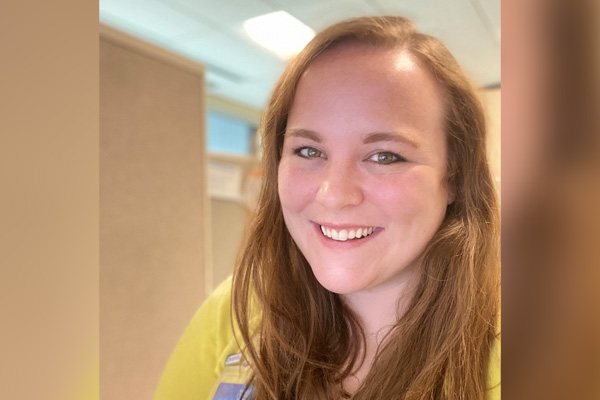A scramble to launch telehealth programs keeps patients with COVID-19 at home
April 27, 2020

Mayo Nurse Manager Brittney Dahlen, BSN ’14, leads team of nurses caring for patients with coronavirus
Typically, it can take months for Brittney Dahlen, BSN ’14, RN, and her team to launch a new remote monitoring telehealth program for patients at Mayo Clinic. But the COVID-19 pandemic meant creating programs specific to the disease within two weeks.
“With COVID-19, we saw everything on an accelerated timeline,” said Dahlen, an ambulatory nurse manager for the Center for Connected Care Remote Patient Monitoring Program at Mayo Clinic. “We’re helping conserve personal protective equipment through eConsults and Bedside app tablets, keeping patients at home and connecting them with their care team via video visits, so we knew we needed to develop the program quickly.”
Mayo Clinic offers 14 to 21-day programs for patients with COVID-19. Low-risk patients with COVID-19 test their vitals twice a day and answer symptom questionnaires, which are monitored 24 hours a day by a team of nurses who help respond when data points indicate the need. High-risk patients with COVID-19 are provided a tablet embedded with cellular service and Bluetooth peripherals like a blood pressure cuff and monitor, pulse oximeter and weight scale. They also receive a thermometer, which isn’t Bluetooth capable. When a patient uses the Bluetooth peripherals, the vitals are uploaded to the tablet and the patients input their temperature. This data is then automatically transferred into the patient’s electronic health record for providers and nurses to review.
“With COVID-19, we're finding that the oxygen saturations are one of the first indicators that a patient is declining,” said Dahlen. “Having that pulse oximeter there and setting up really strict parameters on that has been really helpful in identifying when patients are declining.”
The art of nursing care
The care COVID-19 patients receive from nurses is more than analyzing data. “Our nurses are experts in being able to identify the hidden information that the patient is not always telling you,” said Dahlen. “You have to gain trust from the patients to become the investigator. It's definitely a fine art.”
COVID-19 has sped up that process. “It’s allowed us to develop that rapport with patients much more quickly because they are scared,” said Dahlen. “They are uncertain and anxious. Making sure that we provide our patients with an experience that can help ease their fears and reassure them that we are watching over them is our most immediate challenge.”
Response requires long hours, sleepless nights
The pandemic has meant not only working faster, but also being more nimble, as more information about the disease is known. “We're learning so much about it every day, so we’re fine tuning the program. Our infectious disease and internal medicine colleagues are learning from their colleagues in New York about how the disease is progressing out there,” she said. They learned that instead of watching for oxygenation levels dipping below 90%, it can be more useful to look for them dipping below 5% of a patient’s baseline. “Because oxygenation a huge factor in the patients declining, that's something we’ve really focused on,” said Dahlen. “We’ve had some really good catches where we’ve noticed a patient declining, intervened and helped escalate care.”
To launch these programs so quickly has tested Dahlen. “The best way I have described it is it's the biggest jigsaw puzzle that you have ever had and you have no idea what the final picture should look like,” said Dahlen. “It’s been many long hours, sleepless nights, and a few tears shed here and there.”
Dahlen, who is a student in the University of Minnesota’s Doctor of Nursing Practice program in the health innovation and leadership specialty, said she’s grateful she’s been able to lean on peers in the program and professors. “The program has allowed me to expand my thinking and really be able to think on that systems level of who we need at the table to help ensure that when we move forward with programs to serve patients that we're serving them in the best way that we can,” said Dahlen.
She already has her eye on how this pandemic will change the future of health care. “We're still unsure of what the future of COVID-19 holds, but we know that being able to provide care for patients that is easy for them to access, whether that’s telehealth or virtual care, is something that is needed,” she said. “We will definitely have a new normal out of this and I think it's going to be one that relies on making sure that we serve our patients and those that we care for in a manner that better suits them.”